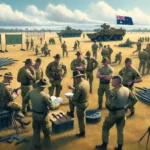The Senior Australian and New Zealand Army Test (SANZAT) stands as a keystone in the military cooperation between Australia and New Zealand, two nations with a long history of collaboration and comradeship. The alliance between the Australian Defence Force (ADF) and the New Zealand Defence Force (NZDF) is exemplified through the SANZAT, an extensive military exercise designed to assess and improve the capabilities of senior army professionals from both countries. This test plays a crucial role not only in strengthening the military bonds between the two nations but also in ensuring that their armies are well-prepared to face the challenges of modern warfare and peacekeeping missions.
SANZAT is far more than a simple military drill; it is a comprehensive regimen that tests the intellectual, physical, and leadership abilities of senior army personnel. These exercises are meticulously crafted to simulate the stress and complexities of real-world military operations. The benefits of such rigorous training are multifold, as they enhance joint operational readiness, foster interoperability, and promote a mutual understanding of each nation’s military strategies and procedures.
One of the primary objectives of the SANZAT is to foster leadership skills. In today’s dynamic threat environment, effective leadership is critical. The test challenges senior officers to take charge of diverse and complex scenarios. Leadership during SANZAT involves decision-making under pressure, strategic thinking, and the ability to adapt to rapidly changing situations. These are skills essential not only on the battlefield but also in humanitarian assistance and disaster relief operations, where both the ADF and NZDF have historically played significant roles.
Another vital component of the SANZAT is to evaluate the participating personnel’s tactical and strategic acumen. The exercises are designed to reflect the current geopolitical climate and potential scenarios that the military forces might encounter. This demands an up-to-date understanding of modern warfare tactics, including cyber warfare, asymmetrical warfare, and the utilization of advanced technology on the battlefield. By keeping abreast of such trends, the ADF and NZDF ensure that their senior army professionals are ready to command in the 21st century.
Physical endurance and mental resilience are also put to the test. The SANZAT includes physically demanding activities that mimic the rigors of military engagement. Practicing under these conditions helps service members maintain peak physical condition and develop the mental toughness required to lead troops effectively. It also ensures that inter-army relations are formed on a foundation of mutual respect and understanding of each unit’s strengths and capabilities.
Furthermore, SANZAT significantly contributes to the two nations’ joint operational capabilities. It presents an opportunity for both armies to integrate their forces and refine the techniques required for combined operations. This is particularly beneficial as Australia and New Zealand often work closely on international peacekeeping missions under the auspices of the United Nations or other multilateral forces. Joint exercises like these enable seamless collaboration and support, reinforcing the ANZAC spirit that has been an integral part of both countries’ military identities.
Communications and logistics, two key aspects of military operations, are also rigorously evaluated during SANZAT. The ability to convey commands, share intelligence, and coordinate movements between units is crucial for any successful military endeavor. Moreover, ensuring that the military supply chain can withstand the demands of an operational scenario is vital. SANZAT tests these aspects thoroughly, often under simulated hostile conditions, to ensure that when the time comes for real-world deployment, both armies can function as a cohesive, well-oiled machine.
The SANZAT is not only about preparing armed forces for conflict; it is equally focused on preparing them for peacekeeping and humanitarian missions. Natural disasters, such as earthquakes and tropical storms, are frequent in the Pacific region. Australia and New Zealand are often among the first responders to these crises, providing aid and support to affected countries. Through SANZAT, senior army personnel receive the training required to lead these humanitarian efforts effectively, ensuring that they can make a positive impact when it matters most.
In addition to fostering military excellence, the SANZAT is an excellent platform for cultural exchange. As personnel from the ADF and NZDF work closely together, they gain a deeper appreciation for each other’s military traditions and cultures. This enriches the experience of all participants and contributes to a stronger, more unified approach to defense matters in the region.
Investments in technology and innovation are also central to the SANZAT. In the modern battlefield, the integration of cutting-edge technologies can provide a significant tactical advantage. By incorporating the latest equipment and software into their training regimen, both the ADF and NZDF ensure that their senior personnel are proficient in the use of advanced military hardware and systems. From drones and satellite communications to modern weapon systems and defense technologies, SANZAT serves as a testing ground for the tools that will shape future military endeavors.
To sum up, the Senior Australian and New Zealand Army Test is more than just a set of military exercises. It is a comprehensive program designed to foster leadership, enhance joint capabilities, promote interoperability, and prepare both nations’ armed forces for the diverse challenges they may face in the current global landscape. As the security dynamics of the Asia-Pacific region continue to evolve, SANZAT stands as a testament to the collaboration and readiness that the ADF and NZDF have built together. This partnership helps to ensure stability and security in the region, demonstrating the continued relevance and importance of the Australia-New Zealand military alliance in today’s complex world.

